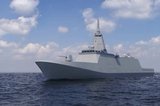Naval Warfare magazine: MCMVs, International interoperability and crewed-uncrewed teaming
What’s inside this edition:
Comment: New (old) kids on the NATO block
While Finland and Sweden have maintained close relations with NATO since its foundation, their decisions to apply for membership will fundamentally change the dynamics of operations and international cooperation in the Baltic Sea.
Features include:
Dull, dirty and dangerous: The 3Ds driving modern minehunting
Described as a ‘3D’ mission – dull, dirty and dangerous – mine clearance is undergoing a revolution, moving away from crewed MCMVs to uncrewed and autonomous systems.
Patchwork alliance: Stitching together NATO’s common practices
The range of equipment and practices found throughout NATO member states poses a significant challenge to naval operations. To ensure strength in diversity, a number of policies have been developed, providing a common framework for cooperation.
From USVs to autonomy: Human-machine teaming in the naval domain
People still remain crucial as navies worldwide are looking to invest in surface and subsurface uncrewed systems. Without effective teaming, uncrewed vessels are unlikely to be the force multipliers decision-makers hope them to be.
Non-traditional weapons: Defence at the speed of light
As the threats on the future battlefield become more advanced, armed forces are looking to laser-based technology. With near-instant flight time and less demand on storage space for ammunition, these weapons are well equipped to deal with the growing prevalence of hypersonic and swarming technology.
Strait talk: Taiwan caught between a rock and hard place
While routine Chinese threats of reintegrating its so-called rogue province are not new, against the backdrop of the invasion of Ukraine, this rhetoric is amplified. How could Taiwan defend against a neighbour which has more resources in every way?
Bonus content coming soon.
Read the edition here.
More from Naval Warfare
-
![Mitsubishi eyes future with Australia’s Mogami selection]()
Mitsubishi eyes future with Australia’s Mogami selection
With Australia’s selection of the Mogami-class for Project Sea 3000, Mitsubishi is investigating local production in the next decade as potential export opportunities emerge.
-
![Thales’ new Sonar 76Nano could equip UK Royal Navy on anti-submarine warfare missions]()
Thales’ new Sonar 76Nano could equip UK Royal Navy on anti-submarine warfare missions
The new sonar is designed to equip uncrewed underwater vessels, with the potential to be used by the Royal Navy for its Atlantic Bastion and Atlantic Net missions.
-
![Hanwha wins Australian government approval to increase its stake in Austal]()
Hanwha wins Australian government approval to increase its stake in Austal
The contract would mean the two shipbuilders can collaborate strategically and enhance shipbuilding capabilities in Western Australia.





















